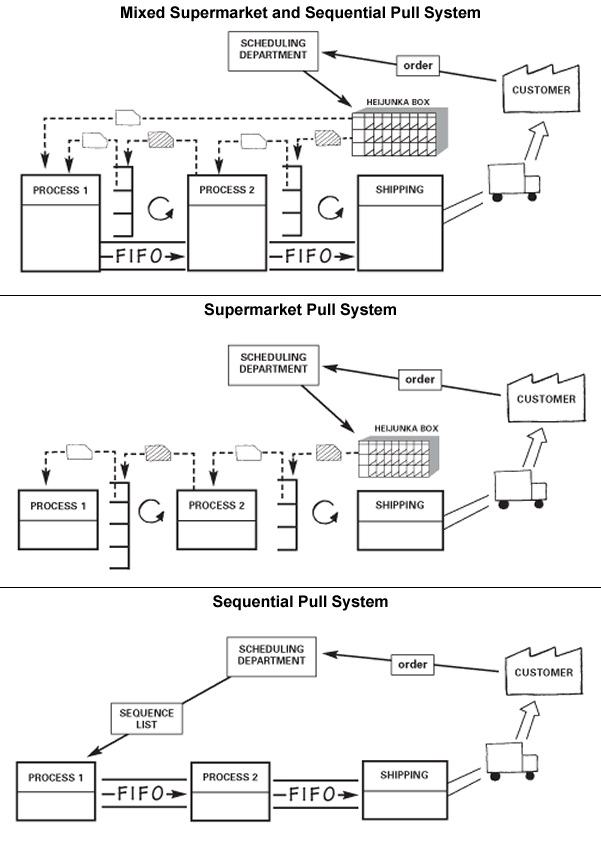Pull Production
A method of production control in which downstream activities signal their needs to upstream activities. Pull production strives to eliminate overproduction and is one of the three major components of a complete just-in-time production system.
In pull production, a downstream operation, whether within the same facility or in a separate facility, provides information to the upstream operation, often via a kanban card, about what part or material is needed, the quantity needed, and when and where it is needed. Nothing is produced by the upstream supplier process until the downstream customer process signals a need. This is the opposite of push production.
There are three basic types of pull production systems:
- Supermarket Pull System
The most basic and widespread type, also known as a fill-up or replenishment or a-type pull system. In a supermarket pull system each process has a store—a supermarket—that holds an amount of each product it produces. Each process simply produces to replenish what is withdrawn from its supermarket. Typically, as material is withdrawn from the supermarket by the downstream customer process, a kanban or other type of information will be sent upstream to the supplying process to withdraw product. This will authorize the upstream process to replace what was withdrawn.
Each process is responsible for the replenishment of its supermarket, so daily management of the worksite is relatively simple and kaizen opportunities are relatively easy to see. The disadvantage of a supermarket system is that a process must carry an inventory of all part numbers it produces, which may not be feasible if the number of part numbers is large. - Sequential Pull System
A sequential pull system—also known as a b-type pull system—may be used when there are too many part numbers to hold inventory of each in a supermarket. Products are essentially “made-to-order” while overall system inventory is minimized.
In a sequential system, the scheduling department must set the right mix and quantity of products to be produced. This can be done by placing production kanban cards in a heijunka box, often at the beginning of each shift. These production instructions then are sent to the process at the upstream end of the value stream. Often this is done in the form of a “sequence list,” sometimes called a “sequential tablet.” Each following process simply produces in sequence the items delivered to it by the preceding upstream process. FIFO of individual products must be maintained throughout.A sequential system creates pressure to maintain short and predictable lead times. In order for this system to work effectively, the pattern of customer orders must be well understood. If orders are hard to predict, production lead time must either be very short (less than order lead time) or an adequate store of finished goods must be held.
A sequential system requires strong management to maintain, and improving it may be a challenge on the shop floor. - Mixed Supermarket and Sequential Pull System
Supermarket and sequential pull systems may be used together in a mixed system—also known as a c-type pull system. A mixed system may be appropriate when an 80/20 rule applies, with a small percentage of part numbers (perhaps 20%) accounting for the majority (perhaps 80%) of daily production volume. Often an analysis is performed to segment part numbers by volume into (A) high, (B) medium, (C) low, and (D) infrequent orders. Type D may represent special order or service parts. To handle these low-running items, a special type D kanban may be created to represent not a specific part number but rather an amount of capacity. The sequence of production for the type D products is then determined by the method the scheduling department uses for sequential pull system part numbers.
Such a mixed system enables both supermarket and sequential systems to be applied selectively and the benefits of each are obtained, even in environments where the demand is complex and varied. The two systems may run together, side-by-side horizontally, throughout an entire value stream, or may be used for a given part number at different locations along its individual value stream.A mixed system may make it more difficult to balance work and to identify abnormal conditions. It also can be more difficult to manage and conduct kaizen. Therefore, discipline is required to make a mixed system work effectively. (Adapted from Smalley 2004, pp. 17–20.)
